When I got married, I registered for one Silpat baking sheet, but I got three -- and I kept them all. Sure, maybe it's because I'm too lazy to go through the trouble of a return (we kept all nine of the king-size pillows we received, even though we only registered for four), but I also use them frequently, so it's nice to have more than one.
"Silpat" is the brand name for the type of silicone baking mat that I own, but a quick Google shows that other brands make the same product. The mats are nonstick, and the silicone helps distribute the heat more evenly for a better finished product. This is a particularly valuable feature for anyone who battles a finicky oven that likes to burn their baked goods. The cleanup is a breeze -- simply wipe down the surface with a sponge and dry. Some folks store them rolled up, but I prefer to store mine flat.
Let's take a look at the pros and cons of using a Silpat. (Hint: Even the cons aren't cons, and the pros are awesome.)
Silpat Pros
The strongest arguments in the Silpat's favor are:
1. It is a reusable piece of equipment, so you save money on other liners (parchment paper, foil) and you throw out less waste. 2. The Silpat is nonstick, which makes cleanup easy. 3. The silicone material distributes heat for more even baking and a better final product. 4. Easy to clean -- residue wipes right off
There really are no arguments "against" Silpat; you shouldn't use it for cooking at temperatures above 480 °F, so it's not ideal for what -- broiling? Roasting red peppers? I can live with that kind of limitation. A Silpat isn't a total replacement for parchment paper, as parchment paper can be manipulated and used to line pans, while the Silpat only lies flat on a cookie sheet or tray. Again, I can live with that limitation.
Here are a couple of my favorite things to make using my Silpat. The Parmesan Crisps benefit the most from the even heat distribution, but I also love the way the Silpat protects the bottoms of the Italian cookies, keeping them from over-browning.
Parmesan Crisps
These simple crisps are the perfect accompaniment to soups, but they make a great garnish or just a tasty snack. All you need is a bunch of parmesan cheese, a baking sheet lined with a Silpat and an oven set to 350 °F. The silicone sheet keeps the cheese from burning, and cooks them evenly.
You can use pre-grated parmesan, or you can freshly grate it yourself. If you decide to grate it, I recommend a medium grate; if it's too fine, the texture results in a weaker crisp. Or at least I think so.
Place rounded tablespoons of the cheese onto the Silpat, making sure it's neatly mounded -- this will ensure the cheese melts into one large, flat crisp -- leaving about three or four inches between each mound. Before baking, just slightly flatten the top of the cheese mound with your fingers or the back of a spoon. Bake for five to seven minutes, until crisps are golden; they will look like thin, lacy cookies. Loosen the edges of each crisp gently with a spatula and remove to a cooling rack or plate.
Rose Felice's Lemony Italian Cookies
If a cookie could save the world, it would be one of these. Iced lemon cookies are my favorite; every time I go to an Italian wedding, I eat all of them off the plate before anyone else can get to them. This recipe comes from my mom's pal, Rose, and it gets rave reviews every time I make them. (Naturally, you can change the flavoring: orange, anise, vanilla -- you get the idea.) I have adapted Rose's recipe a bit, to make them "lemony." If you remove the lemon zest and juice, you can make these cookies "plain," which are also very good.
In a large bowl, combine:
• 3 cups AP flour • 4 1/3 tsp. baking powder • 3/4 cup sugar
Mix these three ingredients together well, and then add one stick of softened butter (or margarine) and crumble with the dry ingredients.
In a one-cup measuring cup, mix:
• 2 beaten eggs • 1 tsp. vanilla • Enough milk to bring mixture to one full cup • Zest of 1/2 lemon (add a squeeze of lemon juice if you want it extra-lemony)
Add wet ingredients to the dry ingredients. Mix together with a large (I prefer wooden) spoon to make the dough. Roll the dough into a ball and chill for 30 minutes. Line cookie sheets with Silpat mats and preheat the oven to 375 °F.
When the dough has chilled, roll into balls approximately one inch in diameter; place on cookie sheet with space left between for cookies to expand. Bake each batch for six to eight minutes; let cool completely, and glaze.
Glaze? Yeah, glaze. You could use store-bought frosting, but why? So here's the recipe:
• 1 cup confectionery sugar • 1 tbsp. plus 1 1/2 tsp. milk • 1 tsp. vanilla • Juice from 1/2 lemon, plus zest from whole lemon
Mix these ingredients until the consistency is smooth. If it is too loose from the lemon juice, add a bit more confectionery sugar. Season to taste, adding more zest and/or juice if needed. Drizzle glaze over completely cooled cookies and let the glaze set at room temperature, or in the refrigerator.
(Sorry I don't have any photos of the cookies. We are leaving on vacation, and my husband went all dictator on me and wouldn't let me buy more milk OR eggs -- he takes emptying the fridge pre-trip very seriously.)
Follow Eating Our Words on Facebook and on Twitter @EatingOurWords





